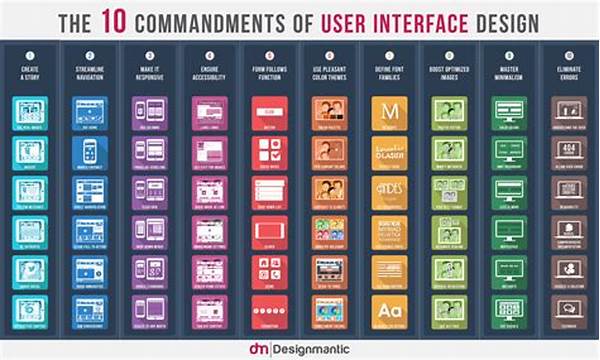In today’s digital landscape, touch interfaces have become ubiquitous, shaping the way we interact with devices daily. As the demand for seamless and engaging user experiences grows, it’s crucial to focus on designing typography for touch interfaces. Appropriate typography ensures readability, aesthetics, and functional communication, playing a pivotal role in how users perceive and engage with digital content. This article will explore various facets of typography in touch interfaces, guiding designers to create visually appealing and user-friendly applications.
Read Now : Insight Into Varied Creative Processes
The Importance of Readability in Touch Interface Typography
Readability is the backbone of any successful design, and designing typography for touch interfaces demands keen attention to this element. When users interact with touch interfaces, they seek immediacy and clarity. Typography must be legible even on smaller screens, which is why font size and typeface choices are critical. Sans-serif fonts are often preferred for their clean and modern appearance, aiding in legibility across various devices. Additionally, contrast between text and background enhances readability, ensuring users can effortlessly decode information. Therefore, understanding the user’s environment and lighting conditions becomes essential when designing typography for touch interfaces. The key takeaway is that clear, accessible, and well-organized typography contributes to a positive user experience, making it an indispensable consideration in interface design.
Key Considerations in Touch Interface Typography
1. Design requires attention to scale, ensuring fonts are legible in various screen sizes.
2. Contrast enhances readability, vital for users in diverse lighting scenarios.
3. Typeface selection impacts aesthetic and usability, influencing user interaction.
4. Consistency in font usage fosters a cohesive user experience.
5. Responsive design allows typography to adapt dynamically to screen orientation.
Balancing Aesthetics and Functionality in Typography
The task of designing typography for touch interfaces involves balancing aesthetics and functionality to create visually engaging and user-friendly designs. While aesthetics attract users and make applications appealing, functionality ensures that the text communicates effectively. This balance is pivotal as designers strive to create interfaces that are not only pleasing to the eye but also intuitive to navigate. To achieve this, designers must focus on various elements such as font choice, size, color, and spacing. Each of these elements contributes to the overall look and feel of the interface, influencing how easily users can read and understand the information presented.
Moreover, designing typography for touch interfaces requires adapting to user interactions. As users swipe and tap, they expect immediate feedback and seamless content flow. Responsive typography helps maintain text clarity and legibility, regardless of how the interface is manipulated. Designers must also consider device orientation and varying screen sizes, ensuring that typography remains consistent and functional across different contexts. Ultimately, the interplay between aesthetics and functionality in typography sets the tone for user interaction, impacting user engagement and satisfaction.
Choosing the Right Fonts for Touch Interfaces
Selecting appropriate fonts is crucial in designing typography for touch interfaces. The right typeface influences user experience by impacting readability and overall aesthetics. A well-chosen font aligns with the brand’s identity and supports the interface’s functionality, while poor choices can hinder user engagement and comprehension. Here are ten key factors to consider:
1. Legibility across various screen sizes.
2. Harmony with the overall design and brand image.
3. Effective use of sans-serif fonts for simplicity.
4. Flexibility in adapting to various device orientations.
5. Ensuring text clarity through spacing and kerning.
Read Now : Digital Illustration Online Interactive Classes
6. Consistency with other typographic elements.
7. How the font choice complements interactive elements.
8. Adapting style to content purpose and audience.
9. Adjusting for accessibility and ease of use.
10. Balancing innovation with familiarity for ease of interaction.
Challenges in Designing Typography for Touch Interfaces
Designing typography for touch interfaces presents a unique set of challenges that require thoughtful considerations and innovative solutions. First and foremost, varying screen sizes pose a significant challenge. Devices range from small smartphones to large tablets, necessitating responsive typography that adjusts seamlessly across different sizes. Additionally, designers face the difficulty of maintaining consistency in typography when transitioning between portrait and landscape orientations. Ensuring legibility without compromising visual appeal is another hurdle designers encounter. This includes choosing appropriate font sizes and types that remain clear and readable under diverse lighting conditions—a factor increasingly pertinent in mobile environments. Moreover, designers must integrate typography with interactive elements, such as buttons and links, without disrupting the interface’s flow or cohesion.
Another challenge lies in the balance between aesthetic allure and functional clarity. While innovative fonts may attract users, they must not impede comprehension or interaction. Finally, cultural and linguistic diversities require designers to adapt typography across different languages, ensuring the text remains effective globally. Overcoming these challenges involves a collaborative approach, combining design intuition with user research and testing. Ultimately, mastering these aspects is essential in designing typography for touch interfaces that are both visually captivating and user-centric.
Evolution and Trends in Touch Interface Typography
Typography for touch interfaces is continually evolving, influenced by technological advancements and user expectations. Modern trends emphasize minimalistic designs, where simple, clean fonts dominate, reflecting the demand for clear and straightforward communication. In designing typography for touch interfaces, designers increasingly adopt variable fonts, which adjust seamlessly to different screen sizes and orientations, offering a flexible, high-performance typographic solution. This evolution supports the growing trend of responsive design, essential for multi-device interaction. Color and contrast also play a pivotal role, with designers experimenting with bold hues to create striking visuals while maintaining readability.
Additionally, functional typography is gaining attention, where every typographic choice serves a purpose beyond aesthetics. This includes fonts designed specifically for dyslexia or visually impaired users, ensuring inclusivity and enhanced user experience. The trend toward incorporating motion in typography is also emerging, adding dynamic elements that captivate users and create engaging experiences. Another noteworthy trend is the blending of typography with interactive elements, creating interfaces that are not only dynamic but also intuitive to navigate. These trends illustrate a shift towards designing typography for touch interfaces that prioritizes functionality, user engagement, and accessibility, shaping future design landscapes.
Summary of Typography Design for Touch Interfaces
In sum, designing typography for touch interfaces necessitates a delicate balance between aesthetics and functionality, demanding a nuanced understanding of user behaviors and interaction patterns. Typography forms the cornerstone of user interface design, influencing how users perceive and interact with digital content. With the pervasiveness of touch interfaces, the significance of clear, legible typography cannot be overstated. Designers must consider varying screen sizes, device orientations, and lighting conditions when choosing fonts, ensuring adaptability and coherence across platforms.
The trend toward responsive typography underscores the need for versatility, allowing text to maintain its integrity regardless of the user’s device. In this context, variable fonts are particularly advantageous, offering flexibility and improved performance. Furthermore, inclusivity in typography design extends a welcoming hand to all users, bridging accessibility gaps and offering a more comprehensive user experience. As designers continue exploring evolving trends and technologies, the emphasis remains on creating engaging, user-centric interfaces. Ultimately, designing typography for touch interfaces is about crafting journeys that are not only visually appealing but also intuitive and inclusive, setting the stage for a more connected digital future.



